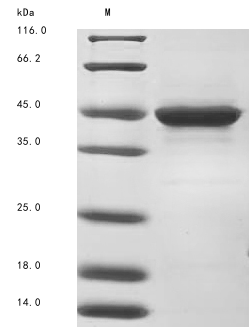Recombinant Human Developmentally-regulated GTP-binding protein 2 (DRG2) is produced in E. coli and contains the complete protein sequence spanning amino acids 1 to 343. An N-terminal 6xHis-tag is attached to streamline purification and detection processes. SDS-PAGE analysis confirms the product reaches over 85% purity, which appears to provide reliable experimental results for research applications.
DRG2 belongs to the GTP-binding protein family and likely plays a role in cellular processes such as signal transduction and protein synthesis. The protein seems to be involved in important pathways that regulate cell growth and differentiation. This makes it an intriguing target for studies related to cellular development and function. Researchers often turn to DRG2 to explore how it contributes to these fundamental biological mechanisms.
Potential Applications
Note: The applications listed below are based on what we know about this protein's biological functions, published research, and experience from experts in the field. However, we haven't fully tested all of these applications ourselves yet. We'd recommend running some preliminary tests first to make sure they work for your specific research goals.
Human DRG2 is a GTPase that requires precise folding, proper GTP-binding domain formation, and specific tertiary structure for its functional activity in cellular development processes. The E. coli expression system can produce soluble proteins, but may not support an optimal eukaryotic folding environment. The N-terminal 6xHis-tag is relatively small and may cause minimal steric interference. While the full-length protein (1-343aa) contains all functional domains, including the GTP-binding domain, the probability of correct folding with functional GTPase activity requires experimental validation. The homologous bacterial expression system increases the likelihood of proper folding, but functional GTP-binding and hydrolysis capability need verification.
1. Protein-Protein Interaction Studies Using Pull-Down Assays
This application requires proper folding validation. DRG2 interactions with regulatory partners require precise tertiary structure and functional GTP-binding domains. If correctly folded (verified through structural and functional assays), the protein may identify physiological interaction partners. If misfolded/unverified, there is a risk of non-specific binding or failure to replicate genuine protein complexes.
2. Antibody Development and Validation
This application is highly suitable as antibody development relies on antigenic sequence recognition rather than functional protein folding. The full-length protein provides comprehensive epitope coverage for generating DRG2-specific antibodies. The high purity (>85%) ensures minimal contamination-related issues during immunization protocols.
3. GTPase Activity Biochemical Assays
This application carries a significant risk without functional validation. DRG2's GTPase activity requires precise GTP-binding site formation and catalytic competence. If correctly folded and active (verified through GTP hydrolysis assays), the protein may be suitable for kinetic studies. If misfolded/inactive (unverified), enzymatic assays will yield biologically meaningless results.
4. Structural and Biophysical Characterization Studies
These studies are essential priority applications for determining folding status. Techniques should include circular dichroism spectroscopy to assess secondary structure, size-exclusion chromatography to evaluate oligomeric state, and thermal shift assays to determine stability. The small His-tag minimizes interference with structural studies.
5. Cell-Free Functional Reconstitution Assays
This application requires rigorous functional validation. Reconstitution assays depend on native protein conformation and GTPase activity. If correctly folded and active (verified), limited functional studies may be possible. If misfolded/inactive (unverified), results will be biologically misleading.
Final Recommendation & Action Plan
The E. coli expression system with a small His-tag is favorable for producing DRG2, but experimental validation of structural integrity and GTPase activity is essential before functional applications. Begin with Application 4 (Structural Characterization) to assess folding quality through CD spectroscopy, SEC, and validate GTP-binding and hydrolysis capability using standard GTPase assays. Applications 1, 3, and 5 require rigorous functional validation before proceeding. Application 2 (antibody development) can proceed immediately. For reliable DRG2 research requiring native functionality, confirm GTPase activity and consider including appropriate nucleotide-binding controls in all experiments.






